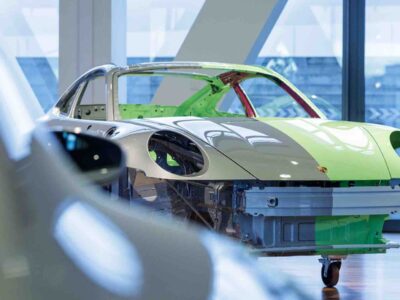There are few automotive companies as important to the start of the electric vehicle (EV) industry as Nissan. The introduction of the Nissan Leaf in 2010 cemented the brand as an early leader of EV technology, selling over 600,000 cars throughout the decade and becoming one of the most successful electric vehicles of that era. However, the industry is becoming increasingly competitive, and brands have to redefine themselves to keep up with its dramatic shift towards electrification.
For Nissan, it’s come in the form of the Ariya, a striking new electric crossover charged with challenging the new electric crossover market – and one of fifteen new EVs that Nissan will release over the decade.
To prepare for the large influx of EVs, Nissan and its partners with Renault and Mitsubishi have developed a brand new electric platform called the Common Modular Family-EV (CMF-EV) platform that will be used to create the evolution of their coming EV lineup, starting with the Ariya.
The Ariya, whose first deliveries are set to hit the road this fall, will mark a new era of Nissan automotive design, described by its stylists as “Timeless Japanese Futurism.” The unique style is characterized by its simplicity, which features sheer concave side-paneling and long continuous lines that sweep unwaveringly around the car, which adds to an elegant design. The more practical exterior design parts, like the lights, are noticeably thin, leaving plenty of room to appreciate the more aesthetic design features. The grille panel, a feature absent on most EVs, was designed to mimic the Japanese Kumiko style of woodworking, with the ornate geometric patterns also appearing in the car’s interior.
2023 Nissan ARIYA Interior & Exterior Design
The interior is a study in Japanese minimalism, with everything stripped to its barest essentials and put perfectly in its place. The dashboard and infotainment center has been pared back to just two screens. The digital dashboard display can be toggled using the buttons on the steering wheel, and the infotainment center is buttonless, opting instead for a touchscreen and haptic feedback “buttons” set into the wood panel below it. The center console follows the same setup, employing only a shifter and a few buttons to change the drive mode and move the console itself. Even the Kumiko-inspired ambient lights found under the console and the door handles are designed in a way that manages to merge form and function. The result is a beautifully flowing interior that naturally projects its “timeless” quality.
In terms of specs, the Nissan Ariya is definitely on the leisurely side of the performance spectrum, although it certainly doesn’t pretend to be anything else. Available in either an four wheel drive (FWD) or an all wheel drive (AWD) configuration with two different battery options, the Ariya tops out at 300 miles of battery range, which puts itself within striking distance of the Tesla Model Y’s 330 miles. In addition, the car’s e-Pedal regenerative braking system extends the range even further. Off the line, the Ariya enjoys a reasonable thrust, with the quickest 0-60mph test topping out at 4.9 seconds on the AWD version of the car. However, the FWD is considerably slower at 7.2 seconds. In terms of power, the Ariya’s single motor FWD powertrain puts out either 214 or 238 horsepower, while the dual-motor AWD version boosts the output total to 389 thanks to their e-4ORCE all-wheel-drive setup.
The Ariya starts at $47,125 and should be available this fall. Although the car may not be the most powerful, Nissan ensures that it will be the most comfortable with a variety of safety and driver assistance options, thanks to their ProPILOT Assist 2.0 system. It includes hands-free single-lane highway driving features and lane change assistance, blind-spot detection, and a variety of cameras and sensors.
The Nissan Ariya displays everything that makes Nissans so desirable at its best. Its futuristic design, spacious interiors and thoughtful engineering remind us of what a forward-thinking brand can do. If the Ariya is Nissan’s way of defining the start of their large-scale electric initiative, then we should all be excited about more.





